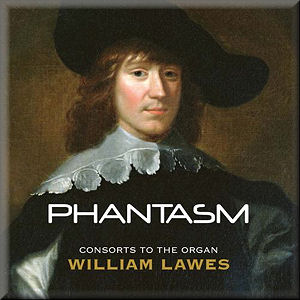 |
 |
|


alternatively
CD: MDT
AmazonUK
AmazonUS
|
William LAWES (1602-1645)
Consorts to the Organ
I Set a5 in g - Fantazya; the Playnsong: a5; Aire a5 [8:53]
II Set a5 in a - [Fantasy no1]; Fantazia a5 [no 2; [Aire] a5 [10:03]
III Set a5 in c - Fantazia a5; Aire a5 [no 1]; Paven a5; Aire a5
[no 2] [12:55]
V Set a5 in C - Fantzy a5; Paven a5; [Aire] a5 [9:56]
VI Set a6 in g - Paven a6; Fantazy a6; Aire a6 [12:09]
VIII Set a6 in F - Aire a6 [no 1]; Fantazy a6 [no 1]; Aire a6 [no
2]; Fantazy a6 [no 2] [12:17]
IX Set a6 in B flat - Aire a6; I nominy a6 [11:28]
 Phantasm (Laurence Dreyfus (treble viol and director), Wendy Gillespie
(treble viol), Jonathan Manson (tenor viol), Markku Luolajan-Mikkola
(bass viol) with Emilia Benjamin (tenor viol) and Mikko Perkola
(bass viol) and
Phantasm (Laurence Dreyfus (treble viol and director), Wendy Gillespie
(treble viol), Jonathan Manson (tenor viol), Markku Luolajan-Mikkola
(bass viol) with Emilia Benjamin (tenor viol) and Mikko Perkola
(bass viol) and  Daniel
Hyde (organ)). Daniel
Hyde (organ)).
rec. 30 August to 1 September 2011, St Martin’s Church, East
Woodhay, Berkshire (U.K.).
 LINN CKD399
LINN CKD399  [77:44]
[77:44]
|
|
|
Phantasm has championed the work of William Lawes’s elder
contemporary John
Jenkins in the past, and that from more than one source.
They have also recorded Gibbons,
William Byrd on the Simax label and John
Ward for Linn in 2009, and most recently more Byrd
for Linn in 2011. The viol consort is beefed up here with the
addition of a chamber organ which Lawes uses mostly to double
the viol parts, sometimes also giving it independent passages
which can generate striking contrasts of timbre.
William Lawes served as one of Charles I’s valued musicians,
becoming known to the court before an official appointment as
‘musician in ordinary’. The ‘viol consorts
to the organ’ would have been intended for the private
environment of the King’s Privy Apartments, a prestigious
responsibility which also allowed Lawes freedom from the aesthetic
conventions expected by his musical peers. Laurence Dreyfus’
excellent booklet notes tell us at every opportunity about Lawes’s
irreverent approach to composing, and his “zany universe”
and “wayward musical personality.” Without a good
deal of expertise in the conventions of the time it might be
hard for lay listeners to detect Lawes’s lawlessness,
as the degrees of naughtiness are often either subtly integrated
or demand a certain amount of foreknowledge, even though you
are likely to sense that strange things are happening
as the programme progresses. Help is at hand however. Dreyfus
is at pains to point out as many references as possible in his
booklet notes on each piece, adding in timings so that we can
listen and nod in sage agreement, learning as we go about the
marvels to be found.
Marvels and masterpieces indeed there are to be found here,
and too numerous to name. Many an inspiring session can be had
with this release, and the booklet becomes hard to put down
with all of those interpretations and revelations being something
for which the mind becomes increasingly hungry. With performances
as deliciously expressive as these we can perhaps allow Dreyfus
a little poetic license in some of his descriptions, certainly
since they will no doubt have informed the manner of performance.
With results like these, who’s complaining?
Just take, more or less at random, the Paven a5 on track
12. There’s a little descending interval which occurs
at 3:13 and 4:15, when carried through to its logical imitative
conclusion creates crashingly ‘wrong’ dissonances.
You can just imagine Lawes discovering this and rubbing his
hands with glee at the way it works and how it can be resolved.
What, take it out? Never! Dreyfus personifies Lawes’s
music in his descriptions, bringing the pieces to life in ways
which enhance the recording no end. We have mad pedal points,
musicians behaving badly, and the smell of sheep and muskets
to name just a few. If you want a breath-taking ‘modern
music’ angle have a listen to the Aire a6,track
16’s “hyperventilated fracas of dissonant false
relations.” Another fun and fascinating moment can be
found in the Fantazy a6 at track 20, where you can find
“a fatal harmonic shock” which is followed by “some
of the most dissonant music he ever wrote, mixing modes promiscuously.”
If this doesn’t make you want to find out more then I
fear there is nothing else to be done.
With a superb recording both in stereo and SACD surround this
is a release to be acquired and treasured. William Lawes is
by all accounts an admirably individualistic composer, and for
all fans of viol consort music this is a ‘must have’
release. I would go as far as to say it should have this status
for all collectors of good music in any era. If you’ve
never explored this genre, this recording will open your eyes
and ears and have you baying for more.
Dominy Clements
|
|

